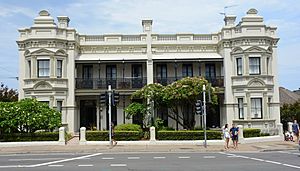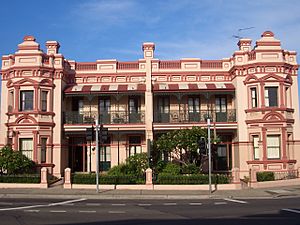Corana and Hygeia facts for kids
Quick facts for kids Corana and Hygeia |
|
|---|---|

Corana and Hygeia in 2016
|
|
| Location | 211-215 Avoca Street, Randwick, City of Randwick, New South Wales, Australia |
| Built | 1893–1894 |
| Architectural style(s) | Victorian Italianate |
| Official name: Corana and Hygeia; Corana & Hygeia Victorian Terraces; Corona | |
| Type | State heritage (built) |
| Designated | 2 April 1999 |
| Reference no. | 454 |
| Type | Terrace |
| Category | Residential buildings (private) |
| Lua error in Module:Location_map at line 420: attempt to index field 'wikibase' (a nil value). | |
Corana and Hygeia are two historic semi-detached houses located at 211-215 Avoca Street in Randwick, a suburb of Sydney, Australia. These beautiful homes were built between 1893 and 1894. They are also known by other names like Corana & Hygeia Victorian Terraces and Corona. Today, the property is privately owned and has even been called The Lurline. Because of their special history and design, Corana and Hygeia were added to the New South Wales State Heritage Register on April 2, 1999. This means they are protected and important to the history of New South Wales.
Contents
History of Corana and Hygeia
Early Indigenous Life
Before Europeans arrived in the late 1700s, the land where Corana and Hygeia now stand was used by Aboriginal people. They lived in the Sydney region for at least 20,000 years. The local Aboriginal groups, like the Cadigal people, used the area for fishing and cultural activities. Signs of their life, such as rock carvings and tools, can still be found in the wider Sydney area. By the mid-1800s, many Aboriginal people had either moved away or sadly died from European diseases.
Randwick's Colonial Beginnings
One of the first land grants in this area was given to Captain Francis Marsh in 1824. Later, in 1839, William Newcombe bought land near what is now Avoca Street.
The suburb of Randwick gets its name from a town in England called Randwick, Gloucestershire. This name was suggested by brothers Simeon and James Pearce. Simeon Pearce came to Australia in 1841 as a surveyor. He bought land from Marsh and built his home, calling his property "Randwick." The Pearce brothers bought and sold a lot of land in the area. Simeon also worked hard to get a road built from Sydney to Coogee and helped Randwick become an official municipality.
Early Randwick was a bit isolated from Sydney because of swamps and sandhills. Travel was difficult, with horse-buses often getting stuck in the sand. Society in Randwick was also divided. Wealthy people lived in large, fancy houses. But working-class people lived in smaller homes, often working in market gardens or piggeries. There was even a very poor area called Irishtown, where families lived in makeshift houses.
In 1858, the NSW Government passed a law allowing towns to form their own local councils. Randwick was the first suburb to apply and became a municipality in February 1859.
The Randwick Racecourse
Randwick was a popular spot for sports and even illegal activities from early on. In 1863, John Tait helped establish the Randwick Racecourse. This was a big deal for Randwick. The racecourse made the area more popular and prosperous. Horse-buses were replaced by trams, connecting Randwick to Sydney more easily. Today, Randwick is still a busy place with homes, businesses, and a lively community.
The Story of Corana and Hygeia
The land where Corana and Hygeia stand was originally bought in 1853 by Judge Callaghan. After he passed away in 1863, his wife Elizabeth and daughter Mary decided to build these two large attached houses. They likely built them to rent out. Records show that the houses were being built in 1893 and finished in 1894.
From 1894 to 1897, only one of the houses was lived in. It was even used as a house and post office for a few years! The postmaster, J. A. Kelly, lived and worked there. In 1898, the post office moved, and both houses were finally occupied. This was the first time the names "Corona" and "Hygeia" appeared in records for the homes.
Over the years, different people lived and worked in the houses. For example, doctors lived in Corona in 1918, and a dentist worked in Hygeia from 1911 to 1944. After 1919, the names Corona and Hygeia were no longer commonly used. In 1925, Hygeia was even listed as flats.
In 1984, people became worried about the condition of the buildings. An order was put in place to protect them while their importance was studied. After some discussions, a permanent protection order was made in 1988. Finally, on April 2, 1999, Corana and Hygeia were officially added to the State Heritage Register. Today, the buildings are used as rental homes.
What Corana and Hygeia Look Like
Corana and Hygeia are a pair of large, semi-detached mansions. They are designed in the late Victorian Italianate style. This style often features grand designs and decorative details.
The houses have a stucco finish, which is a type of plaster. They have fancy, decorated walls on the roof called parapets. They also have classical-looking pediments over the curved front sections and above the window frames. There are deep decorative moldings that go around the sides of the houses.
The verandahs at the front and back have beautiful iron lace decorations and cast iron columns. The front verandahs on the ground floor have attractive tiles. The original roof was likely made of slate, but it is now covered in tiles.
Inside, many of the original wooden features in the main rooms are still there. A special feature of these houses is the use of native bird designs in the decorations. You can see these birds in the colorful leadlight windows on the stair landings and above the front windows. Bird designs are also found on the keystone (the top stone) of an arch around one of the fireplaces and on the hearth tiles.
Condition of the Buildings
As of 2011, the buildings were in good condition. They have been cared for over the years.
Changes Over Time
- In 1985, approvals were given for painting, repairing damaged plaster, wooden trims, and flooring. The roof and verandah tiles were also repaired.
- In 1994, the houses were restored and updated to be used as residential accommodation.
Why Corana and Hygeia are Important
Corana and Hygeia are very important to the history and look of New South Wales. They are two beautiful semi-detached mansions built in 1898 in the late Victorian style.
They are special because of their design. They have lovely cast-iron work on the verandahs, decorated roof parapets, and tiled verandah floors. They also have attractive front fences made of cast iron and stone. These houses add a lot to the look of the High Cross area in Randwick.
Their history is also important because they are connected to the family of Judge Thomas Callaghan. He was a well-known citizen and judge in the community.
Because of all these reasons, Corana and Hygeia were officially listed on the New South Wales State Heritage Register on April 2, 1999.


